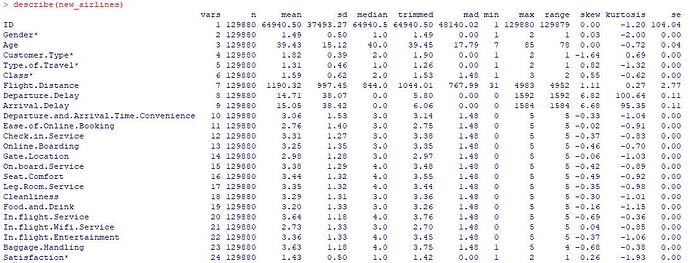Thanks for posting. Please see this link for best practices for asking a question. It isn't totally clear to me what exactly you are asking. For example, are you just asking for definitions of mean, standard deviation, kurtosis, etc.? Or are you looking for more specific interpretation in light of your dataset? What question are you trying to answer about your data? Putting these sorts of things in your questions can make it easier for the community to help.
Sorry for the unclear questions. I'm looking for a more specific interpretation of the dataset.
Hi @Chempaka_Rose, In this case is important use a visual help because you have many variables.
First you need know the definition about each item showed in describe.
For see the distribution and correlation, and identify other metrics in visual form use this:
library(pysch)
pairs.panel(new_airlines)
That's still a pretty big question. I can give you some basic definitions for those terms if that is what you are asking - but to show summary statistics from your dataset and ask to have them all explained for every variable is probably too broad a question for this forum. You may have better luck with your question if you tell us what goal you are trying to accomplish, and what you have tried already to accomplish that goal.
With that being said, for what it's worth, here are some basic definitions of the terms you are asking for:
- mean: A measure of central tendency, typically calculated by adding up all observations and dividing that sum by the number of observations
- standard deviation: a measure of dispersion. A good heuristic for thinking about standard deviation is that the higher the standard deviation is, the further apart each observation is from other observations (this is just a heuristic and strictly speaking isn't mathematically true).
- trimmed: I'm not sure what function you are using to produce this, but this probably refers to a trimmed mean. A trimmed mean is the same as the mean mentioned above, but it excludes values on either extreme. A typical example would be to remove the 10% of values that are highest, 10% of values that are lowest, and calculate the mean from the remaining values.
- kurtosis: This is a measure of "tail fatness". A normal distribution has a kurtosis of 3. A kurtosis higher than three indicates fat tails i.e. more extreme outliers, and vice versa for a kurtosis of less than 3.
This topic was automatically closed 21 days after the last reply. New replies are no longer allowed.
If you have a query related to it or one of the replies, start a new topic and refer back with a link.
